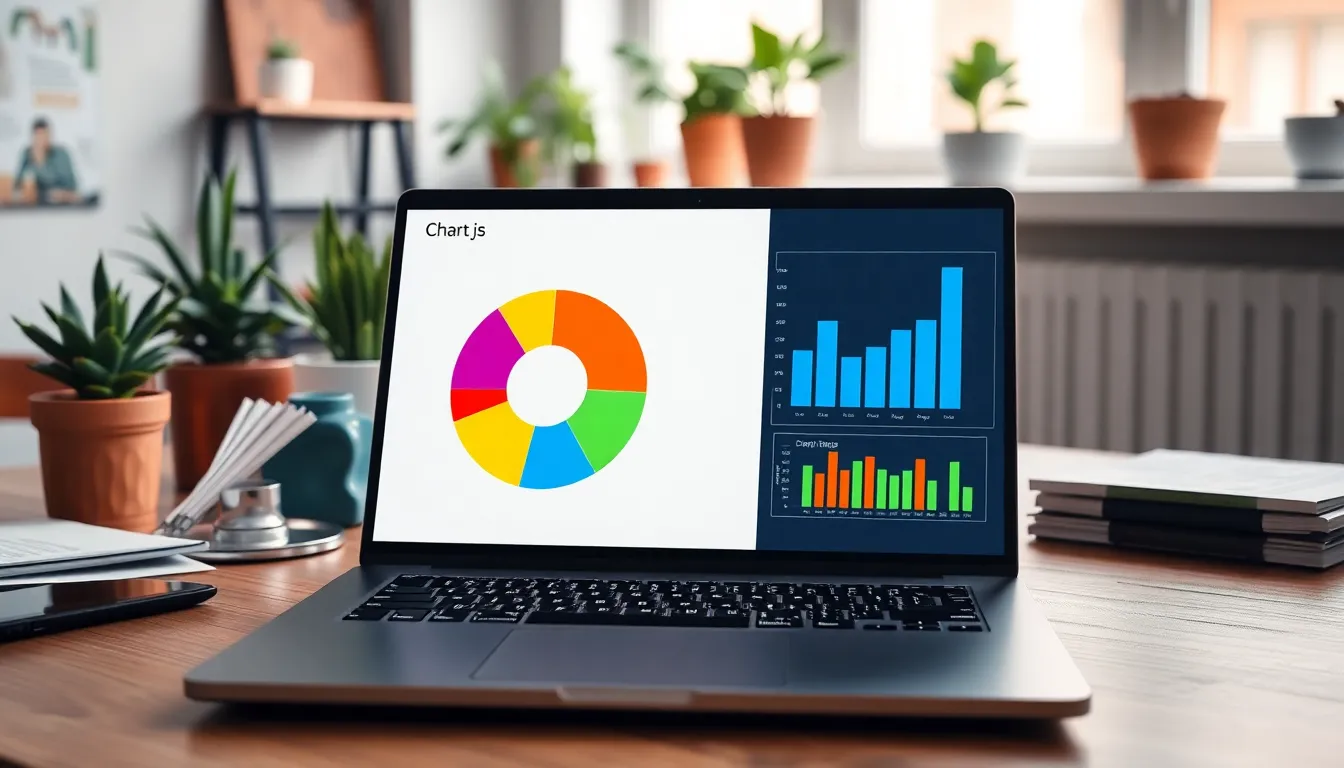Table of Contents
ToggleIn a world overflowing with data, turning numbers into eye-catching visuals can feel like trying to find a needle in a haystack. Enter Chart.js, the superhero of chart integration that swoops in to save the day. With its simple syntax and stunning graphics, it’s like having a personal designer for your data—minus the hefty price tag and the coffee runs.
Understanding Chart.js
Chart.js serves as a versatile JavaScript library for creating interactive charts. Developers find it user-friendly, making it accessible for those with limited coding experience. Offering a range of chart types, Chart.js includes bar, line, radar, doughnut, pie, and polar area charts, among others.
Customization options in Chart.js stand out. Users can adjust colors, fonts, and layouts, enhancing the overall visual appeal of their data presentations. Data can be plotted in real-time, making it ideal for applications that require constant updates or live information feeds.
Integration with various frameworks is straightforward. Chart.js works seamlessly with libraries such as React, Vue, and Angular. This compatibility enables developers to enhance the interactivity of their web applications efficiently.
Performance remains a key feature of Chart.js. The library employs canvas elements for rendering charts, providing superior performance for complex visualizations. Minimal loading times contribute to smooth user experiences.
Documentation and community support enhance learning. Chart.js features comprehensive guides and examples for users at all skill levels. An active community shares plugins and best practices, enabling quicker problem resolution and implementation.
Chart.js not only simplifies data visualization but also empowers users to create compelling stories behind their data. Understanding these capabilities opens up numerous possibilities for effective communication through visuals.
Benefits of Chart Integration

Chart.js offers numerous advantages that enhance data presentation and user interaction. Organizations leverage these benefits to create more effective visual communication.
Enhanced Data Visualization
Chart.js transforms raw numbers into clear visual stories. Users can choose from multiple chart types, enabling effective representation of different datasets. Customization options allow adjustments in colors, fonts, and layouts, making charts not only functional but appealing. The flexibility of responsive design ensures that charts look good on any device. Furthermore, its capability for real-time data updates means users observe changes instantly, providing an accurate reflection of current situations. By simplifying complex information, Chart.js helps businesses convey insights swiftly to stakeholders.
Improved User Engagement
Engaging users becomes effortless with interactive charts created using Chart.js. The library supports hover effects, tooltips, and clickable legends, all of which encourage exploration of data. Such interactivity maintains users’ attention and promotes deeper understanding. By allowing users to manipulate views, Chart.js fosters a hands-on approach to data analysis. Organizations can boost retention rates by creating memorable experiences through visually compelling charts. Ultimately, increased user interaction leads to better decision-making informed by visually engaging data insights.
Setting Up Chart.js
Setting up Chart.js involves a few straightforward steps that ensure efficient chart integration. The process is quick, enabling users to start visualizing data in no time.
Installation Steps
To begin, include Chart.js in the project. Users can import Chart.js via npm with the command npm install chart.js, or they may link to a CDN in the HTML file. Using the CDN involves adding this script tag: <script src="https://cdn.jsdelivr.net/npm/chart.js"></script>. After integrating Chart.js, it’s essential to verify successful installation by checking the console for errors. A proper installation guarantees users access to all the library’s functionalities for creating interactive charts.
Basic Configuration
Basic configuration sets the foundation for using Chart.js effectively. First, users must create a canvas element in the HTML file, as this serves as the drawing area for charts. For instance, code <canvas id="myChart"></canvas> defines the canvas. Next, users create a JavaScript function to initialize the chart and set it up with the desired type, such as line or bar. Within this function, options like data and configuration settings enable custom styling, color adjustments, and tooltips. Completing these steps prepares the charts for dynamic data representation and user interaction.
Implementing Chart Integration
Chart.js allows users to implement chart integration seamlessly. Following the correct steps ensures effective data visualization.
Connecting Data Sources
Connecting data sources makes charts more informative. Users can link Chart.js to various data sources like JSON files or REST APIs. These connections facilitate dynamic updates to the visualizations in real-time. By utilizing the fetch API or libraries like Axios, developers can retrieve data effortlessly. Importantly, parsing the retrieved data into the format Chart.js requires serves as a crucial step. This setup enables transformative presentations of raw data in visually engaging ways.
Customizing Chart Options
Customizing chart options enhances the visual appeal and functionality of charts. Users can adjust properties such as colors, fonts, and labels to suit specific preferences. Chart.js provides an extensive array of options, allowing for tailored experiences that align with brand aesthetics or user expectations. The configuration includes modifying tooltips, creating responsive layouts, and setting chart dimensions. By experimenting with animations, users can create engaging transitions that capture audience attention. Overall, strategic customization fosters engaging data narratives and improves user interaction.
Best Practices for Chart Integration
Integrating Chart.js requires attention to detail to maximize efficiency and user experience. Following best practices ensures charts function seamlessly across various platforms.
Performance Optimization
Prioritize performance by minimizing dataset size. Large datasets can slow loading times, so filtering data before visualization proves effective. Utilize the canvas rendering of Chart.js for enhancing speed. This method allows smooth animations and reduces lag associated with DOM manipulation. Limit the number of charts rendered simultaneously. Each chart consumes resources, impacting overall performance. Finally, leverage performance profiling tools to identify bottlenecks in your chart integration, leading to smarter optimizations.
Ensuring Responsiveness
Focus on responsiveness to provide an optimal user experience across devices. Utilize CSS to make the canvas element fluid. Setting the width and height to 100% allows charts to adapt to screen sizes. Implement options like maintainAspectRatio for improved layout control. Chart.js supports resizing, so enabling responsive settings ensures charts adjust without distortion. Test charts on various devices to confirm functionality. Regular checks help identify layout issues and enhance usability on mobile and desktop platforms.
Conclusion
Chart.js stands out as a leading choice for anyone looking to elevate their data visualization efforts. Its user-friendly interface and extensive customization options empower users to create stunning and interactive charts. By integrating Chart.js into web applications developers can enhance user engagement and provide clearer insights through visual storytelling.
The ability to connect to various data sources and update visualizations in real-time makes it an invaluable tool for dynamic applications. Adhering to best practices ensures optimal performance and responsiveness across devices. With a supportive community and comprehensive documentation users can confidently navigate the world of data visualization with Chart.js.




